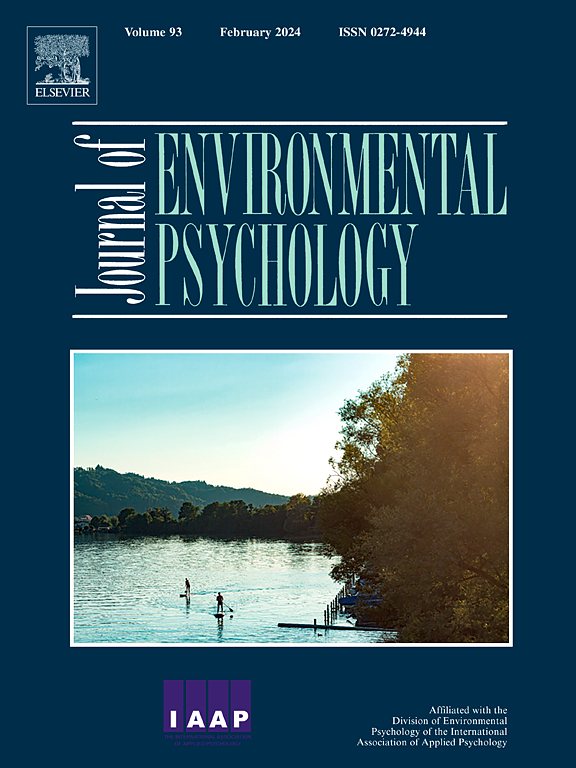室内寻路过程中冲突情境下的策略选择:来自方向和楼层策略的见解
IF 7
1区 心理学
Q1 ENVIRONMENTAL STUDIES
引用次数: 0
摘要
已经确定了室内寻路所采用的各种策略,以及对其激活的特定内部和外部要求。各自的策略使用及其与建筑元素的配置特征和个人对寻路环境的知识或理解的关系已经被调查。然而,当多个策略同时可用但方向相反时,个体是如何从多个策略中最终选择一个策略的,我们知之甚少。本研究考察了这种冲突情境下的策略选择,重点研究了两种基本策略:方向策略和底线策略。对120名参与者进行了受控虚拟环境实验。参与者必须在t型十字路口选择一个方向,每个走廊都有一种或两种策略。参与者根据从十字路口到楼梯的距离被分成三组,即楼层策略的空间线索。结果显示,使用楼层策略的参与者比使用方向策略的参与者有更多的环顾四周的行为。这意味着楼层策略用户可能认为寻路环境不太确定,并以相对理性的方式处理收集到的信息。这一理论解释为室内寻路过程中策略选择的心理过程提供了新的见解,并强调了策略选择与个体信息处理风格之间的潜在联系。本文章由计算机程序翻译,如有差异,请以英文原文为准。

Strategy selection in a conflicting context during indoor wayfinding: Insights from direction and floor strategies
Various strategies employed in indoor wayfinding have been identified, together with specific internal and external requirements for their activation. Respective strategy use and its relationship with both configurational characteristics of architectural elements and individuals' knowledge or understanding of the wayfinding context have been investigated. However, little is known about how individuals ultimately select one strategy from among multiple strategies when they are simultaneously available but lead in opposing directions. This study investigated strategy selection in such conflicting situations, focusing on two fundamental strategies: direction strategy and floor strategy. A controlled virtual environment experiment with 120 participants was conducted. Participants had to choose a direction at a T-intersection where each corridor aligned with one or both strategies. Participants were separated into three groups according to the distances from the intersection to a staircase, i.e., a spatial cue for floor strategy. The results revealed that participants who employed floor strategy engaged in more looking-around behaviors than the direction strategy users. This implies that the floor strategy users might have perceived the wayfinding context as less certain and processed the gathered information in a relatively rational way. This theoretical interpretation provides new insights into the psychological processes involved in strategy selection during indoor wayfinding and highlights the potential links between strategy selection and individual information processing style.
求助全文
通过发布文献求助,成功后即可免费获取论文全文。
去求助
来源期刊

Journal of Environmental Psychology
Multiple-
CiteScore
10.60
自引率
8.70%
发文量
140
审稿时长
62 days
期刊介绍:
The Journal of Environmental Psychology is the premier journal in the field, serving individuals in a wide range of disciplines who have an interest in the scientific study of the transactions and interrelationships between people and their surroundings (including built, social, natural and virtual environments, the use and abuse of nature and natural resources, and sustainability-related behavior). The journal publishes internationally contributed empirical studies and reviews of research on these topics that advance new insights. As an important forum for the field, the journal publishes some of the most influential papers in the discipline that reflect the scientific development of environmental psychology. Contributions on theoretical, methodological, and practical aspects of all human-environment interactions are welcome, along with innovative or interdisciplinary approaches that have a psychological emphasis. Research areas include: •Psychological and behavioral aspects of people and nature •Cognitive mapping, spatial cognition and wayfinding •Ecological consequences of human actions •Theories of place, place attachment, and place identity •Environmental risks and hazards: perception, behavior, and management •Perception and evaluation of buildings and natural landscapes •Effects of physical and natural settings on human cognition and health •Theories of proenvironmental behavior, norms, attitudes, and personality •Psychology of sustainability and climate change •Psychological aspects of resource management and crises •Social use of space: crowding, privacy, territoriality, personal space •Design of, and experiences related to, the physical aspects of workplaces, schools, residences, public buildings and public space
 求助内容:
求助内容: 应助结果提醒方式:
应助结果提醒方式:


